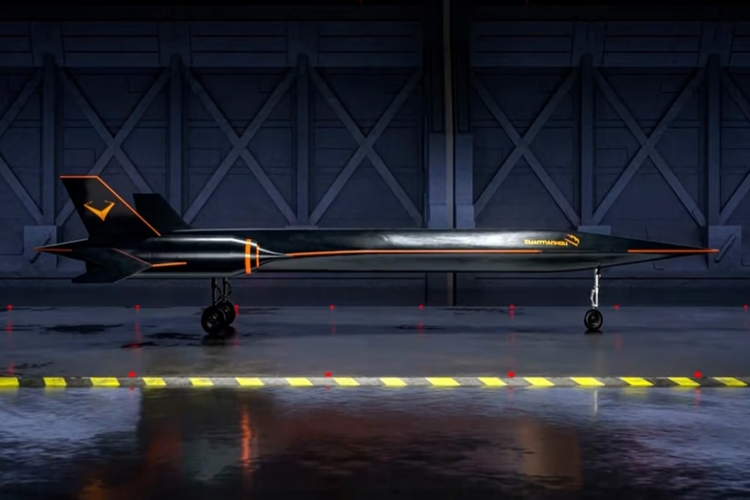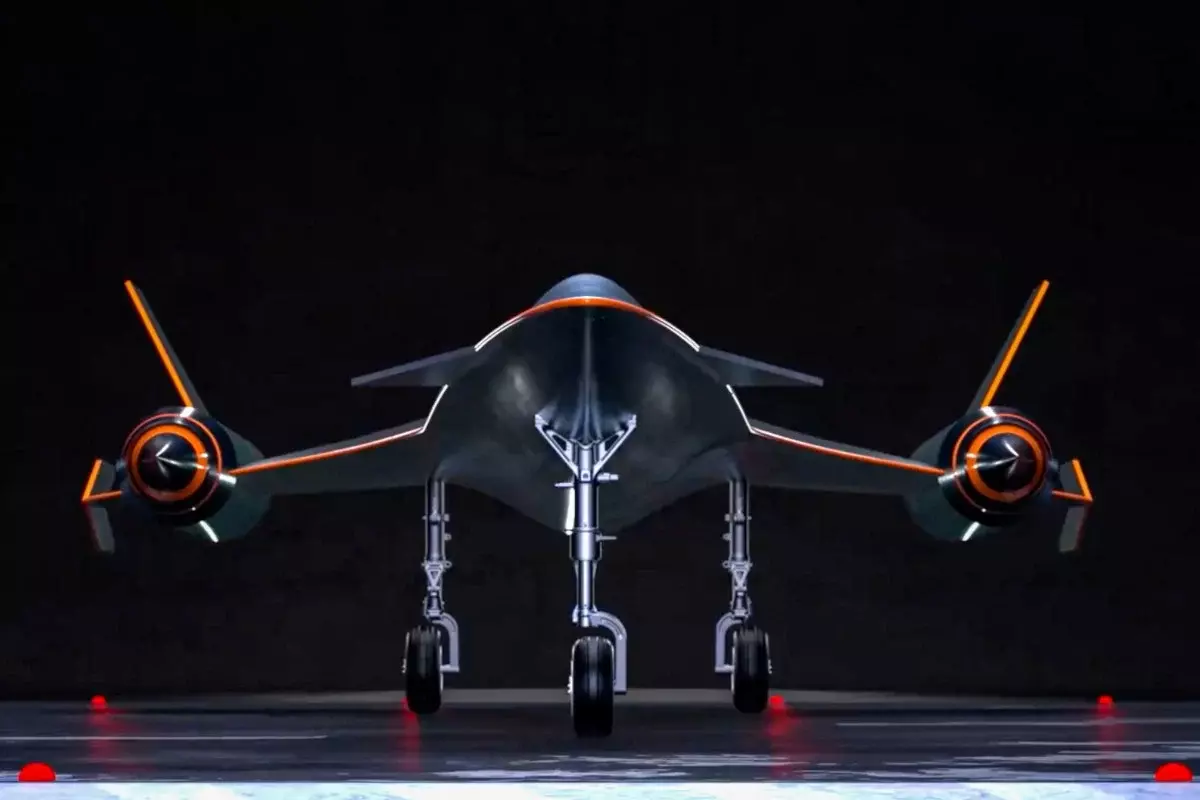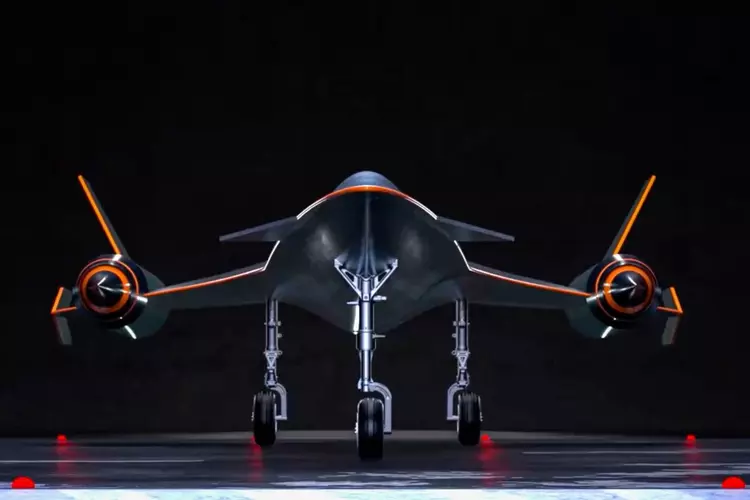China’s push to dominate the next frontier in space exploration took center stage at the Space Tech Expo Europe in Bremen, Germany, where Beijing-based Space Transportation, also known as Lingkong Tianxing Technology, announced the development of a prototype supersonic spaceplane, dubbed “Cuantianhou” or “Flying Monkey.”
Details about the Cuantianhou remain limited. However, a scale model showcased at the Space Tech Expo revealed a design closely resembling the company’s Yunxing supersonic passenger jet prototype, albeit in a smaller, near-identical form.
The ambitious project, first reported by Space News, aims to revolutionize access to space with a versatile, high-speed craft capable of horizontal takeoffs and landings.
Significantly, both the Cuantianhou spaceplane and the Yunxing commercial passenger jet bear a striking resemblance to the iconic American SR-71 Blackbird, raising the question: is this a leap forward in aerospace innovation or another example of China simply copying U.S. designs?


Space Transportation announced in late October that it had successfully completed test flights of the Yunxing prototype. According to reports in Chinese media, the Yunxing is envisioned as a supersonic commercial aircraft capable of reaching speeds of up to Mach 4—up to 3,069 mph (depending on the altitude).
At more than twice the speed of the world’s only successful supersonic passenger jet, the Concorde, the Yunxing could transport passengers from Beijing to New York in less than two hours, revolutionizing long-distance travel. The company aims to launch the first full-scale Yunxing supersonic passenger jet on its maiden flight by 2027.
The Yunxing is designed to accommodate up to 50 passengers. However, Fan Deng, general manager of Space Transportation, revealed to SpaceNews that the new Cuantianhou spaceplane will have capacity for just two passengers and will feature fully autonomous flight controls.
Fan said the Cuantianhou will conduct its inaugural test flight in 2025. The prototype will showcase near-space capabilities, including high-speed horizontal takeoff and landing, much like a conventional airplane. This design eliminates the need for traditional rocket launchpads and recovery systems, offering a more versatile and reusable solution for space missions.
Beyond the stated differences, the exact distinctions between the Yunxing and Cuantianhou remain unclear. In fact, earlier images released by Space Transportation of the Yunxing commercial jet appear to show the same scale model as the Cuantianhou spaceplane displayed at the Space Tech Expo Europe. Notably, the name “Cuantianhou” is prominently displayed on the fuselage in these images.
In English, the name “Cuantianhou” translates to “Flying Monkey,” while “Yunxing” means “cloud travel.”


The images and schematics of the Yunxing and Cuantianhou unmistakably resemble the SR-71 “Blackbird,” the iconic American reconnaissance aircraft that debuted in the 1960s. Known for its sleek, needle-nosed fuselage and delta-shaped wings, the Blackbird was engineered to reach unmatched speeds and altitudes, cementing its status in aviation history as the fastest jet-propelled aircraft ever built.
After nearly three decades in service, the U.S. Air Force retired the SR-71 in 1998. However, reports suggest that Lockheed Martin has been secretly developing a hypersonic successor, the SR-72.
China’s Cuantianhou spaceplane borrows heavily from the Blackbird’s design heritage. Its sharp, angular profile is optimized for minimizing air resistance at hypersonic speeds, while its twin-engine configuration echoes the SR-71’s powerful propulsion system.
The visual similarities between the Cuantianhou and SR-71 are so significant that it’s hard not to assume that China’s engineers weren’t inspired—or directly influenced—by the American spyplane’s design.


While the SR-71 was a marvel of its time, Space Transportation’s stated goal with the Yunxing and Cuantianhou is to leapfrog its predecessor regarding functionality and scope.
Unlike the Blackbird, which was designed for reconnaissance during the Cold War, Space Transportation says its new supersonic aircraft are intended to serve commercial and scientific purposes.
If successful, the Cuantianhou would allow China to perform previously unattainable missions using conventional aircraft. These could include suborbital point-to-point transportation, allowing passengers or cargo to traverse the globe in mere hours, or rapid satellite deployment, crucial in geopolitical tension or natural disasters.
Additionally, the Cuantianhou’s reusable nature sets it apart from traditional single-use rocket systems, aligning with the growing push for sustainability in space exploration. The aircraft promises lower operational costs and faster turnaround times between missions by landing horizontally on a runway, much like the retired Space Shuttle.
The announcement of the Cuantianhou comes at a time when spaceplane development is heating up globally. American companies like SpaceX and Sierra Space, as well as European initiatives, are all racing to create reliable reusable spacecraft. Space Transportation’s project underscores China’s determination to secure a foothold in this competitive arena.
However, some have argued that China’s approach to aerospace innovation often involves replicating existing technologies rather than pioneering new ones. In addition to the Cuantianhou’s similarity to the SR-71, China’s top-secret reusable experimental spaceplane, the “Shenlong” or “Divine Dragon,” appears to be a veritable clone of the U.S.’s equally enigmatic spacecraft, the Boeing X-37.
The striking similarities between China’s latest aircraft and American designs have raised concerns about potential intellectual property theft and espionage, which could further exacerbate tensions between Beijing and Washington.
China’s aerospace ambitions have also come under scrutiny on the geopolitical stage. Critics warn that its dual-use technologies—designed for both civilian and military purposes—could escalate tensions in the increasingly competitive “Cold War” between the U.S. and China over dominance in the space domain.
Despite its ambitious plans, Fan acknowledges that Space Transportation faces some significant challenges in bringing its Cuantianhou spaceplane to fruition.
Developing an aircraft capable of surviving hypersonic flight’s extreme heat and stress requires advanced materials and engineering expertise. The need for precision navigation and propulsion systems adds another layer of complexity to the project.
National regulations on supersonic flight present another significant challenge to Space Transportation’s commercial aspirations. For instance, civil aircraft are prohibited from exceeding Mach 1 (approximately 761 mph) over land in the United States. American companies seeking to test supersonic aircraft must obtain special flight authorization from the Federal Aviation Administration (FAA), adding a layer of regulatory complexity to the development of such technologies.
“One big challenge is technology, and another big challenge, actually, is policy, the aviation policy of different countries,” Fan said. “So in the future, we must do much more work on that.”
Ultimately, the reusable Cuantianhou spaceplane prototype is part of China’s broader strategy to dominate the burgeoning commercial space sector. Designed for high-speed suborbital flights, the craft aims to reduce the cost of space travel while offering flexible, on-demand transportation for satellites, cargo, and even passengers.
If the spaceplane lives up to its promises, it could pave the way for a new era of affordable, sustainable, and versatile access to space. However, questions about the originality of its design—and the broader implications for international aerospace competition—will likely linger.
Editor’s Note: This article has been updated to correct an error in the earlier version, which inaccurately described the speed of Mach 4. We regret the oversight and have revised the information to reflect the accurate speed.
Tim McMillan is a retired law enforcement executive, investigative reporter and co-founder of The Debrief. His writing typically focuses on defense, national security, the Intelligence Community and topics related to psychology. You can follow Tim on Twitter: @LtTimMcMillan. Tim can be reached by email: tim@thedebrief.org or through encrypted email: LtTimMcMillan@protonmail.com

